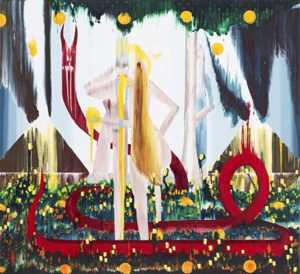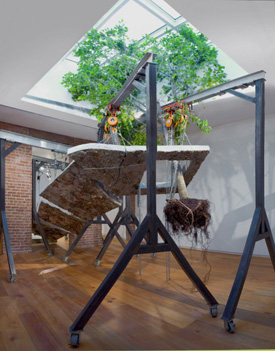And Then There Was Art
John Haberin New York City
Back to Eden and Camille Henrot
Still think we've got to get ourselves back to the garden? Joni Mitchell's "Woodstock" linger in the air, but the hopes of the 1960s are all but gone—and besides you look terrible in bell-bottoms.
Getting back to Eden, though, is a snap. No need to locate the four streams of the river that waters the garden, and no cherubim or flame of the whirling sword will drive you away. Admission to the Museum of Biblical Art is free. It is also just a block west of Central Park's urban paradise. And the eighteen artists in "Back to Eden" seem practically carefree. 
One might never know that art has complicated origins of its own—including a long history of religious imagery. One might not know either how art once found new purposes with secular audiences and a loss of faith. Mostly, though, the selections miss the terrors of art or the Bible. People have spent their lives debating what either one means. A museum can assign contemporary artists to old texts, but is that enough to connect past and present? It puts together a lively show, but less a lost Eden than business as usual.
Camille Henrot takes the Bible literally, give or take a rewrite by Charles Darwin. Or maybe she takes evolution spiritually, give or take running it through a video editor and an anxious mind. At the center of "The Restless Earth," she recites a mash-up of them both, while images flash by of everything from The Origin of Species and the fossils to back it up to a Pantone chart, lab technicians, and a phablet ad. Perhaps the French artist cannot decide between a phone and a tablet, just as she cannot decide between natural history and a higher plane. Still, when a video begins with "In the beginning," you know that you had better take it seriously—or else. Just do not be surprised if she and five others at the New Museum sound less serious than they think.
West of Eden
No one at the Museum of Biblical Art parses Genesis all that closely, like an illuminated manuscript. No one situates a lost perfection in a modern city, the way the Bible unfolded in the Northern Renaissance, Yosemite became an American Eden for Carleton Watkins, or the theme of the machine in the garden runs through art today, long after Roberto Burle Marx and Modernism's gardens. No one's innocence gives way to tears, as it did so achingly for Hieronymus Bosch. No one is out to recreate paradise either, like Paul Gauguin in Tahiti. The twenty-first century is just not a utopian age. Nor is it half so simple.
One wants to find the rivers in Sean Capone's 1000 Paths (to the Divine) out front, but video's swirling colors bring only rest and relaxation. One wants to find a threat or a questioning in Mary Temple's shadow garden by the admission's desk, painted under the show's credits, but it comes off in context as a logo. One wants to find a dystopia in Marina Zurkow and Zurkow's three-channel animation on the facing wall, but vegetation enters Times Square as casually as daylight. Inside, too, artists get one work apiece, alongside four illustrated Bibles. They might be responding dutifully to a theme. Like Times Square for Jane Dickson, Eden has become a tourist attraction.
Some just do what they always do. Jim Dine adds a Venus de Milo to his tool rack, and lo it becomes a gate to knowledge of good and evil. Pipilotti Rist appropriates gardening tools, too, while projecting her video image onto a vase. She plays a woman's sensuality against her role as homemaker, as again with Pipilotti Rist in retrospective, but most women have more to worry about than garden parties, even on the Upper West Side. Mark Dion should know the soil better, after digging up the dirt under the Museum of Modern Art and helping David Brooks to bring a tree (in the image here) through a gallery skylight. Here his sculpted snake has four feet, from before the fall, when it was still way too cute to crawl on its belly and to bite at man's heel.
 Others are just as literal and just as perfunctory. Linda Puerta's artificial plants top a wall, while Lynn Aldrich's garden hose coils into a bucket without tempting anyone. Still, not everyone gives up so easily. Like Rist, several identify Eve with Eden after the fall. Rona Pondrick's bare, twisted tree emerges from sculpted body parts, and Maria Magdelena Campos-Pons on paper has a woman's hair trailing into nature and fire. And some artists have always been at home with illustration.
Others are just as literal and just as perfunctory. Linda Puerta's artificial plants top a wall, while Lynn Aldrich's garden hose coils into a bucket without tempting anyone. Still, not everyone gives up so easily. Like Rist, several identify Eve with Eden after the fall. Rona Pondrick's bare, twisted tree emerges from sculpted body parts, and Maria Magdelena Campos-Pons on paper has a woman's hair trailing into nature and fire. And some artists have always been at home with illustration.
Anunda Bell's cut paper imagines Eve with an exposed rib cage and a clueless Adam. She also treats them to a swarm of black butterflies. Fred Tomaselli finds an equivalent for the swarm of living creatures across the earth and the vaults of heavens, as they explode outward in an expulsion from paradise (yes, the one by Michelangelo). Barnaby Furnas positively delights in the fall, with poured paint, a bright red serpent, fruit everywhere, Adam and Eve ever so close, and God already walking in the garden. Alexis Rochman's delights extend even to humanity's sad stewardship over nature, with all sorts of creatures plunging with the sewage into Brooklyn's Gowanus Canal. Is her cat prowling or smiling?
Even those artists have little time for moral ambiguity or actual community gardens, and only a few truly believe in darkness. Dana Sherwood's papier-mâché raw meat and moldering pastry had me sympathizing with Eve's preference for raw fruit. Frank Lloyd Wright or Le Corbusier would envy Naomi Reis for her vertical garden, although it bodes the fall of mankind and of Modernism to come. Matt Collishaw's snake slithers behind one's own reflection in a black-framed mirror. And the snakes on a mattress, in a daguerreotype by Adam Fuss, are spookier still. I could barely turn away, but then I had to get back to the garden.
In the beginning
One to a floor, the installations at the New Museum do not all begin at the beginning, but all have an element of sound art. And for all six artists, things may mean a lot more to them than to you. For Hannah Sawtell in the lobby, the serious part is global capitalism, and its sound is a steady hum. Her Terminal Accumulator displays the evidence, in suspect currency, oil barrels tinted gold, and the ruins on which they thrive. Pristine racks and museum cases dare you to identify the photos, if you can. For the Londoner, a former DJ who must have known more danceable rhythms, too much has been robbed of meaning, leaving only hashtags like #bigpharma, #taxhaven2, and #corecollapse.
For Jeanine Oleson, serious means art music, and its sound is an amateur act. Oleson has staged performances of Romantic arias, as The Rocky Horror Opera Show. Hear, Here surrounds a video of the event with the costumes and props to, she hopes, transform it into an "experimental opera." Do not hold your breath. Maybe someone will breathe into the valved horn in polished brass, and maybe someone will part the bleached curtain. Maybe, too, someone will find sanctuary or danger in a felt-lined tent—or maybe not. To judge by a photo of hands running up her neck, at least she will have found ecstasy.
For Ragnar Kjartansson, serious means family, and its easygoing sound is folk guitar. Up to ten performers relax on makeshift home furnishings, not quite covering up the video huffing, puffing, and sighing of Kjartansson's mother. In Me and My Mother, she spits and coughs in his face. In Take Me Here by the Dishwasher, a younger version of her takes down a virile man, in a kitchen soaked in pink light. Now you know how the parents of a true artist meet. (The clip is from an actual Danish film starring his parents, the dialogue from which supplies the guitar lyrics, and the artist, as "family legend has it," was conceived the night after it was shot.) Drawings of The Raging Pornographic Sea do not look terribly pornographic, but winters in Iceland are long, and all sorts of things may enter an artist's mind.
Maybe that is why, when it comes to his mother, David Horvitz keeps a safe distance. For Horvitz, serious means the ends of the earth, and be thankful that their sound is not "Sunrise, Sunset." The California native was considerate enough to let his mother stay put while he traveled to the Maldives, so that their cell phones could capture the horizon at dawn and dusk, and the sound emerges from forty-seven bell ringers each day at noon—their chimes, he swears, "created through the remelting of a French church bell dating back to 1742." Roberto Cuoghi's instruments look back further still, after a serious "two-year study of Assyrian language and rituals." They play from a circle of speakers in a pitch-black room, to recall the fall of empire (in present-day Iraq) around 600 B.C.E., but their lament does not sound all that mournful. The Italian might have a good start on "Nineveh: The Musical."
And that brings one back to the beginning and to video. When it comes to Old Testament times, Camille Henrot prefers Genesis—in what she calls, awkwardly, Grosse Fatigue. "Then came the green algae" to make oxygen and then "the hyenas, the bears, the giraffes." Unfortunately, humans enter the picture, "and then there was violence." Fortunately, they do not do that much damage. At worst lab technicians start walking into walls.
Mostly, Henrot seems optimistic about the encounter between human artifice and nature, although with hints of a darker irony. Stereotypical "savages" cavort lovingly and leisurely on two more videos, while sheets display an old-fashioned natural history of plant life, although the text recreates jewelry ads. A room devoted to the Japanese art of floral arrangements asks, innocently enough, Is It Possible to Be a Revolutionary and Like Flowers? Perhaps not, in an exhibition that brings together Sawtell's politics, Oleson's art, Kjartansson's and Horvitz's family affairs, and Cuoghi's deep history. Henrot touches on them all, although she also shares what Kjartansson calls the search for "genuine emotion through melodramatic gestures." Art may have found a way to recover sincerity amid artifice, or it could make one suspicious of both.

"Back to Eden: Contemporary Artists Wander the Garden" ran at the Museum of Biblical Art through September 28, 2014. Camille Henrot, Ragnar Kjartansson, David Horvitz, and Roberto Cuoghi ran at the New Museum through June 29, Hannah Sawtell through June 22 and Jeanine Oleson through July 6.




